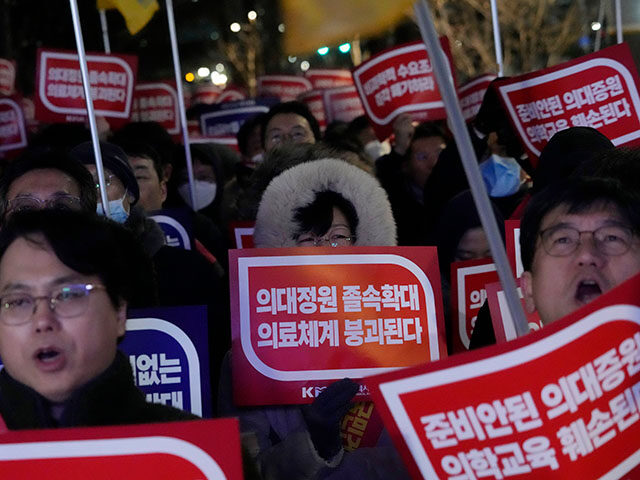Some major hospitals in South Korea have canceled as many as 50 percent of scheduled surgeries between Tuesday and Friday as a result of a massive health worker walkout in which nearly 80 percent of trainee doctors have tendered resignations to their employers.
The doctors launched a mass strike movement on Tuesday to protest the government of President Yoon Suk-yeol introducing a policy to dramatically increase the number of doctors in the country. The Yoon plan would increase the number of medical students by 2,000 in 2025 and ultimately end with an extra 10,000 medical students by 2035. Currently, South Korea’s medical schools allow 3,000 students to matriculate a year.
Yoon’s government has made the case that the move is necessary as a result of already existing doctor shortages, particularly in rural areas, and in anticipation of the rapidly aging population of the country increasingly needing specialized care. South Korea is currently home to 2.6 doctors per 1,000 people; the average in developed nations is 3.7 doctors per 1,000 people. The aging population and low fertility rate has also resulted in a critical shortage of pediatricians, as there are not enough pediatric patients to make the field viable, lowering the number of doctors in that field below what is necessary for the actual number of children needing care.
The doctors objected that increasing the number of available physicians in the country would hurt their salaries and introduce too much competition in the field. Some doctors have also complained that the “plan fails to address issues such as overburdening and the lack of incentives for doctors who specialize in essential health care services, including pediatrics, obstetrics, and emergency medicine,” according to the South Korean newswire service Yonhap.
Most doctors in South Korea work in private hospitals or their own practices, but the Korean government maintains a National Health Insurance program that funds the vast majority of medical treatment in the country.
“Public health care is funded through a combination of payroll taxes, government subsidies, outside contributions, and tobacco surcharges,” a Columbia University synopsis of the South Korean healthcare system explained. “It is not very common to have private health insurance, especially since it only accounts for 4% of health expenditures.”
Yonhap reported on Friday that 8,897 trainee doctors — out of a national total of about 13,000 — had resigned as of Friday, vacating 94 hospitals in Seoul “and elsewhere,” representing 78.5 percent of those working. Another national newspaper, Korea JoongAng Daily, noted that, in addition to trainees, “a total of 9,275 interns and residents at 100 major hospitals in the country submitted their resignation letters as of 10 p.m. Wednesday.”
The Yoon administration initially responded to the strike by threatening to arrest doctors for endangering their patients. By Friday, the federal government announced the highest level of public health crisis, the ranking of “serious” – an unprecedented move, even during the Wuhan coronavirus pandemic, according to JoongAng. At press time, the government has not made moves towards arresting participating doctors.
“The Central Disaster and Safety Countermeasure Headquarters, along with all provinces and cities nationwide, will take comprehensive measures to [address issues arising from] the collective protests against the medical school enrollment quota hike,” Prime Minister Han Duck-soo announced.
“Public medical services will operate at maximum capacity,” Han said. “All public medical institutions will extend the operational hours as much as they could for weekdays and service hours on weekends will be expanded as well.”
The government also announced expanded telemedicine services and easing requirements to hire auxiliary health workers to help the remaining medical staff still working.
“The government is deeply concerned about the aggravated workload burdened by medical staff who are maintaining duties in the hospital,” Han said.”
The government initially expressed outrage at the medical field on Tuesday, condemning doctors for potentially endangering their patients.
“No country in the world has seen medical workers taking collective action while leaving critically ill and emergency patients,” Second Vice Health Minister Park Min-soo told reporters on Tuesday.
“I am disappointed and concerned over the idea of doctors’ groups believing that doctors’ rights come before patients’ lives. The trainee doctors’ right to take collective action cannot have precedence over people’s basic right to life,” Park concluded.
In a scathing commentary published on February 15, in anticipation of threats from doctors to begin the strike, JoongAng Daily contended that the doctors would likely not “win the battle with the public” because their reasons for going on strike were not strong enough.
“Doctors’ reasoning for a collective action cannot gain any sympathy. They can hardly deny a shortage in their number — 2.6 per 1,000 in the population,” the commentary observed. “which is the lowest among members of the OECD after Mexico.”
“Doctors cannot win a battle with the public. If they wish to avoid scorn about their selfishness and elitism, they must back their claims with detailed and accurate data to negotiate with the government before taking a collective action,” the article concluded.
Follow Frances Martel on Facebook and Twitter.

COMMENTS
Please let us know if you're having issues with commenting.